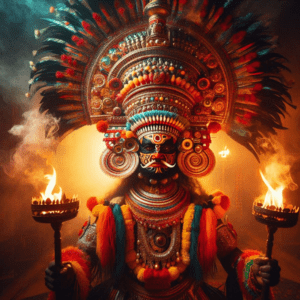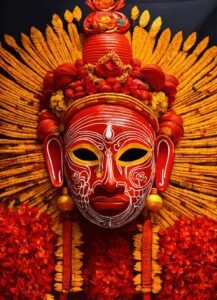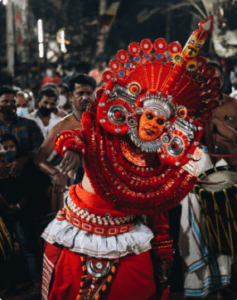Table of Contents
ToggleTheyyam: The Mystique Dance of Gods in Kerala

Theyyam, a vibrant and ancient ritual art form, holds a significant place in the cultural tapestry of Kerala, India. Theyyam, transcends mere performance, transforming into a vibrant tapestry of devotion, mythology, and ancestral reverence. Combining elements of dance, music, and mythology, Theyyam mesmerizes both locals and visitors alike with its mystical performances. This blog delves into the essence of Theyyam, exploring its meaning, historical roots, and the captivating rituals that bring it to life.
Unveiling the Meaning: Theyyam – A Divine Encounter
The word “Theyyam” itself holds a profound significance. Derived from the Malayalam word “Daivam,” meaning god and “Aattam”, meaning dance, Theyyam is interpreted as the “Dance of the Gods”. Theyyam embodies the essence of a divine encounter. It’s not just a dance; it’s a portal where the boundaries between the celestial and earthly realms dissolve. It is a sacred spiritual experience that reflects the rich culture of Kerala. Devotees believe that during Theyyam performances, the spirits of deities, heroes, and ancestors descend upon the elaborately adorned performers, offering blessings and protection.
A Geographical and Temporal Tapestry: Where and When Theyyam Comes Alive
Theyyam flourishes in the North Malabar region of Kerala, encompassing present-day Kasargod, Kannur districts, parts of Wayanad, and pockets of Kozhikode. Lush paddy fields, ancestral homes (Tharavadu), and sacred groves (Kavu) become the stages for this vibrant ritual. The Theyyam season commences on the tenth day of the Malayalam month of Thulam (usually October) and continues for seven months, culminating in Edavam (May-June). This coincides with the harvest season, imbuing Theyyam with an additional layer of thanksgiving and prosperity. A similar custom known as Bhuta Kola is followed in the Tulunadu region of neighboring Karnataka.

A Myriad of Forms: The Diverse Faces of Theyyam
Theyyam isn’t a singular entity; it’s a constellation of over 400 distinct forms, each with its unique costume, story, and significance. Each Theyaam represents a divine entity or a heroic figure who achieved divine status through heroic deeds or virtuous lives. Most Theyyams are believed to be incarnations of Shiva or Shakti (the consort of Shiva). Some Theyyams have strong associations with these principal deities of Hinduism.
From the ferocious Raktha Chamundi, a manifestation of Durga, to the benevolent Kari Chamundi, a protector of children, Theyyam characters encompass a vast pantheon. Heroes like Wayanadu Kulaven, revered for his courage, and ancestral spirits like Gulikan find representation in this vibrant tapestry.
The costumes themselves are breathtaking works of art. Elaborate headgear, often adorned with feathers, leaves, and intricate carvings, add a majestic dimension. Vivid body paint, with symbolic designs and colors, further accentuates the character’s essence. Cascading jewelry, clanging anklets, and vibrant fabrics complete the transformation, creating a spectacle that is both awe-inspiring and deeply meaningful.
The Ritualistic Heartbeat: Unveiling the Performance
Theyyam isn’t merely a visual spectacle; it’s a deeply ritualistic practice. Elaborate preparations precede the performance. Each performer, known as Theyyam Thandan, undergoes rigorous physical and mental training. He observes strict dietary restrictions and engages in devotional prayers to invoke the spirit he’s about to embody.
The performance space itself undergoes a transformation. The Theyyam Sthanam (venue) is meticulously cleaned and adorned with sacred offerings. The rhythmic beats of traditional instruments like the Chenda (drum), Elathalam (cymbals), and Kurumkuzal (wind instrument) create a pulsating soundscape that energizes the atmosphere.
As the Theyyam Thandan emerges, adorned in his resplendent attire, the crowd erupts in reverence. The dance itself is a captivating narrative. Each Theyyam form has its distinct choreography, often incorporating vigorous movements, acrobatic feats, and symbolic gestures. Through this dance, the Theyyam Thandan channels the spirit he embodies, enacting stories from mythology, dispensing blessings, and interacting with devotees. The Theyyam performance can be a dynamic interplay between the performer and the audience. Devotees might seek oracles or blessings by touching the Theyyam’s attire or offering prayers.

The Belief System: A Fusion of Ancestral and Divine
Theyyam draws upon a rich tapestry of beliefs. It reflects the ancient tribal traditions of hero worship and ancestral reverence. The veneration of nature spirits and local deities finds expression in various Theyyam forms. Additionally, Theyyam incorporates elements of Hinduism, with characters like Durga and Vishnu finding representation. This fusion creates a unique and multifaceted belief system that resonates deeply with the local communities.
Beyond Performance: The Lingering Impact of Theyyam
Theyyam transcends mere entertainment. It serves as a powerful social and cultural unifier. It fosters a sense of community, bringing people together in celebration and shared belief. The elaborate costumes and intricate rituals act as repositories of cultural heritage, passed down through generations. Theyyam also serves as a potent medium for social commentary. Certain Theyyam forms address issues like social justice and environmental protection, keeping these themes alive within the community.
Theyyam is more than just a dance; it’s a vibrant tapestry woven from faith, heritage, and artistic expression. It’s a testament to the enduring power of ritual and the profound connection between the human and the divine.
Conclusion
Theyyam is not just a dance; it is a spiritual journey, a bridge connecting mortals to the divine. As performers transform into gods, Theyyam becomes a living testament to Kerala’s rich heritage and unwavering faith.
So next time you witness a Theyyam performance, remember that you are witnessing more than just art—you are witnessing the dance of gods.
Frequently Asked Questions
- Is Theyyam only performed in Kerala?
While Theyyam is primarily associated with Kerala, similar ritualistic traditions can be found in other parts of India, albeit with variations in style and symbolism.
- Are Theyyam performances open to the public?
Yes, Theyyam performances are open to the public, and visitors are welcome to attend and witness the rituals firsthand.
- What is the significance of Theyyam makeup and costumes?
The elaborate makeup and costumes worn by Theyyam performers serve to transform them into divine beings, enabling them to embody the personas of gods and goddesses.
- How long does a typical Theyyam performance last?
The duration of a Theyyam performance can vary depending on the complexity of the ritual and the number of characters portrayed. Some performances may last for several hours, while others may be shorter.
- Can tourists participate in Theyyam rituals?
While tourists are welcome to observe Theyyam rituals, active participation in the rituals is generally restricted to trained performers and members of the local community.
